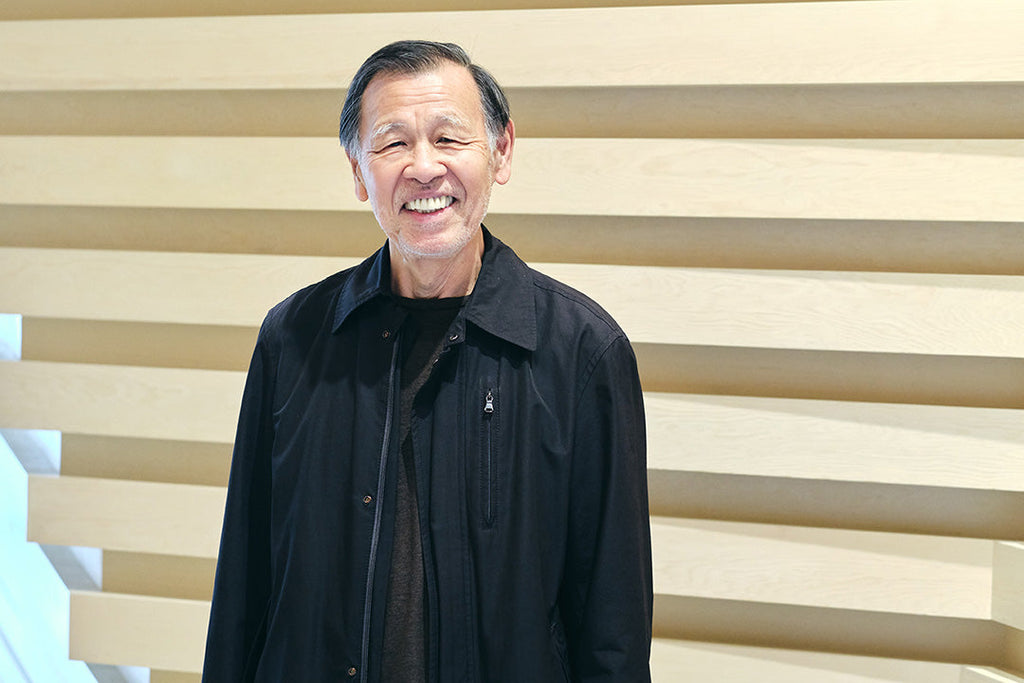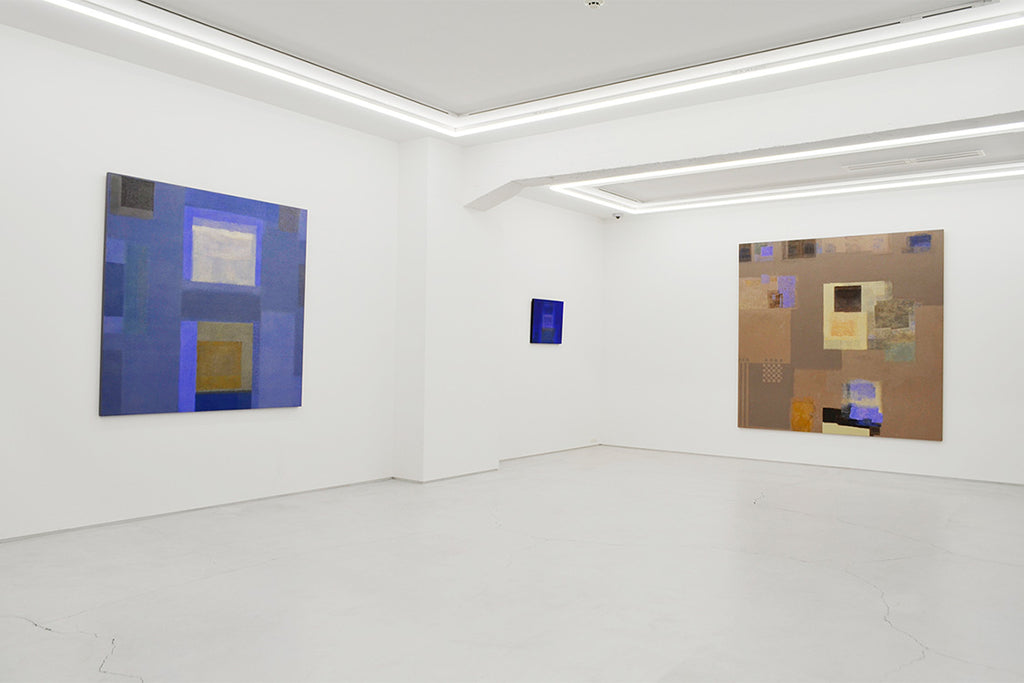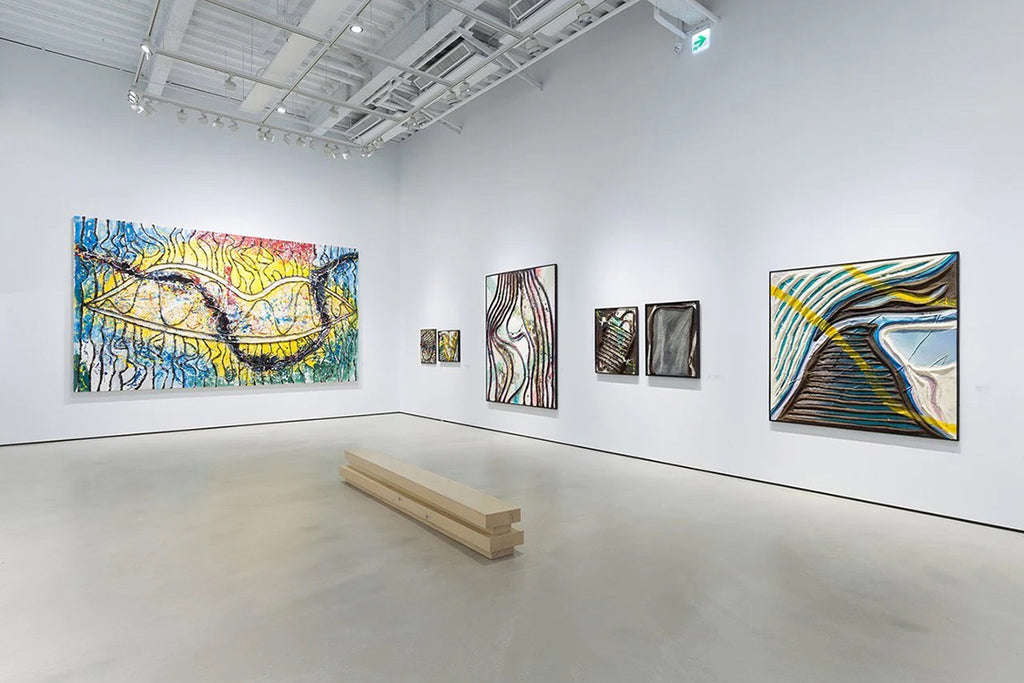ARTICLES
Life in New York as an Artist: Harmony of Art, People, and Space
A New Appreciation Contemporary Japanese and Asian Art
23/23

A New Appreciation Contemporary Japanese and Asian Art
In our ongoing series, we present the digital archive of the book 'A New Appreciation Contemporary Japanese and Asian Art' This book delves into internationally acclaimed artists and the dynamics of the Asian art market. The twenty-second installment features artist Tadaaki Kuwayama and architect Kengo Kuma.
Life in New York as an Artist: Harmony of Art, People, and Space|Interviews of Experts in the Art Industry
Tadaaki Kuwayama
Artist: painting, sculpture, installation
Kengo Kuma
Architect, University of Tokyo Professor

Architect Kengo Kuma (l.) and New York based artist Akira Kuwayama (r.)
The Art Scene in New York: Choosing New York Instead of Paris
Kuma: I’ve heard that your work is currently in a Minimalist exhibition at the Singapore National Museum and that your solo exhibition will be held in Taiwan next month. I am glad to have the opportunity to meet with you in Japan during this busy period in Asia for you. It is our first time to meet each other.
Kuwayama: I spend most of my time in New York, coming back to Japan only for exhibitions.
Kuma: When did you move to New York?
Kuwayama: In 1958.
Kuma: More than 60 years ago. What motivated you to go to New York?
Kuwayama: I was studying painting at Tokyo National University of Fine Arts and Music and I hated the Japanese system there. For example, for the nihonga ( Japanese traditional painting) section, everyone had to act together as a group under a director. This happened in the other departments as well. For me, art was more personal and I needed to be creative. Two years after graduating, I went to New York.
Kuma: In Japan, even leading artists have little freedom.
Kuwayama: That’s right.
Kuma: Of all the cities in the world, what was it about New York that attracted you?
Kuwayama: When I decided to go to the United States, I had an interview at the American Consulate. It was required at that time. Also, airplane travel was only allowed for politicians. We had to go by boat.
Kuma: Right, travel was by boat at that time.
Kuwayama: That’s what they told me at the Consulate. Why did I choose New York? It might have been better to go to Paris, but my thinking was that art could only move forward with financial support. America had won the war and was the richest nation on earth at the time. The only place that interested me in the United States was New York. Looking back, I really thought America was the place for me. It was the center of the post-war world, and action painting and the like were concentrated in New York in 1958.
The Consulate was not aware of that, and most of my contemporaries were still looking to Europe.
Kuma: There was not much information about the United States at that time. It was good foresight on your part.
Kuwayama: I was surprised at first by action painting when I arrived in New York. Actually, action painting was beginning to wind down and it was time for a new movement to appear. Minimalism, and a bit later, Pop Art.
The works in New York were larger in scale than anything I had ever seen before. It was amazing to me. As it was already happening, though, it was not for me. That was at the end of the 1950s, beginning of the 1960s. Thinking about it, my timing was good. It was a turning point in the art scene.
Kuma: In architecture, too, everything in Japan was oriented towards groups. I was suffocating. That’s why I went to New York in 1985. It was a kind of ‘in-between’ time for architecture. Post-Modernism was in its last stages and everyone was wondering what to do next. 1985 was actually really a good time in that sense. Was that your experience as well?
Kuwayama: Yes, 1960 was a good time. There were many new galleries and young curators starting to be active at MoMA, the Guggenheim, and the Metropolitan - William Sites, Henry Geldzahler. They would go around on Mondays, when the museums were closed, searching for new talent. The director of the Leo Castelli Gallery told me that, and he said he would bring them to my studio. I thought it was a joke but he really did bring them and that’s how I got picked up. I don’t know if it was because of the timing, or because the next generation of artists had not yet emerged.
Kuma: In 1985, I was also set on New York (laughs). I went with an Rockefeller American Cultural Council grant. Until then, no architect had received the ACC grant. The artist Tadashi Kawamata had been awarded the year before me, and Kenjiro Okazaki a year later. There was a similar consciousness, thinking of connections between art and architecture, space and architecture. I felt really changed in New York.
I was registered at Columbia University as a visiting researcher. Basically, I just used the library.
Kuwayama: We also had to be registered as students.
Kuma: Where were you affiliated?
Kuwayama: Most of the artists were connected with the Art Students League. Anyone can be admitted, but you have to sign in for attendance every day for immigration. So it was not much use as a school. We would just sign in and go home. Kuma: That’s funny. However, maybe the curators you mentioned might have frequented the school….
Green Gallery
Kuwayama: Have you heard of the Green Gallery? I hadn’t, but the owner asked me to take a look. He was young, maybe three or four years older than me. Henry Geldzahler and others often visited his gallery. When I went, there was an openplan Mark di Suvero exhibition going on. After looking around, I said ‘goodbye.’ The owner took that to mean I had no interest. My English wasn’t very good and I was simply saying ‘goodbye.’ Then Leo Castelli got in touch with me. He started out with “Don’t jump to ‘no.’ I’d like to organize an exhibition of your work.” Kuma: So, did you have an exhibition at Green Gallery?
Kuma: You were very fortunate to have the opportunity to present your work like that just two years after arriving in New York.
Kuwayama: Yes, of course. Luckily, they approached me and wanted my work.
Kuma: What kind of artists did Green Gallery represent at the time?
Kuwayama: George Segal, Dan Flavin, Lucas Samaras, and then Tom Wesselmann and Pop Artists. It was much later, but Kusama Yayoi took part in a group show there as well.
Kuma: Green Gallery was a respected gallery at the time. You were lucky to start out that way and to continue selling your works.
Kuwayama: Well, the works sold for only around 100 to 200 dollars.
Kuma: Still, it is amazing that you were able to do that, to be able to support yourself in New York. I heard stories about difficulties of surviving in New York from Tadashi Kawamata and Kenjiro Okazaki.
Kuwayama: The work we were doing in the 1960s was not understood generally by local Americans. Most of my support came from Switzerland and German.
Kuma: Really?
Kuwayama: Yes. I would not have been able to manage only on American support. In terms of museums and galleries, most of my support was in Europe.
My first museum show was at the Stedelijk Museum in Amsterdam for the Color of Shape exhibition. I was entered as an American. That was in 1966. But I did not have any solo shows at the time and was in bad shape financially. My first solo show was at the Museum Folkwang in Germany in 1974. That gave me some recognition, but almost entirely in Germany. The other artists I knew also had more chances in Germany. Minimalist art was not popular in the US. Nobody bought it. It really didn’t sell in the 1960s. Even Barnett Newman couldn’t sell his works. Ivan Carp who later founded the OK Harris Gallery said it would be ridiculous to ask $1500 for a large work when Marc Rothko could not sell for $1000. That is how it was at that time. Prices started to go up with Pop Art.
Disaster: Everything Lost
Kuma: For me, the medium and materials of drawing are extremely important. You studied nihonga when you were in Japan. How did your materials and medium change when you started producing art in New York?
Kuwayama: I had never used any materials other than those for nihonga. I had never used oil paints. When I went to New York, I brought Japanese pigments with me. However, those pigments need to be suspended in glue and it was too dry in New York for that. Acrylic paints had just come on the market. Sam Francis, who was a neighbor, suggested that I use those. So I made my own emulsion and suspended the powder pigments in that to make my own paint.
Kuma: Did that create a big shift for you?
Kuwayama: Yes, of course.
Kuma: We can see some of the early works by Kazuo Shiraga for example, who had also been working in nihonga but switched to contemporary art. I am interested in knowing what kind of nihonga painting you were doing.
Kuwayama: All of my early paintings were lost in the disastrous September 1959 Isewan Typhoon, also known as Typhoon Vera. There is nothing left. My whole past was washed away.
Kuma: That stage of your life disappeared.
Was Sam Francis an influence on your development?
Kuwayama: No, we were just friends. He also helped us find a place to live. It was a loft that he thought was a little small for himself but just right for us. We lived there until 1976 when we moved to our current location.
Kuma: So, New York was a place for new works. In a way, there was also a feeling of dryness.
Kuwayama: I would add to that the feeling of freedom. I was doing nihonga in my first year there and then gave it up in the second year. (He points to a catalog photo) This work marked my beginning in what I now call Minimalism.
Kuma: How did you change your style? Did it happen right away?
Kuwayama: I started to make pieces with three-dimensional sculptural elements.
Kuma: Your work seems very architectural to me. In architecture, we think about finalizing materials, color scheme, how corners will be - the balance of these. Perhaps you are thinking about similar issues. In architecture, I don’t think it is anymore about grasping the entire silhouette. It is rather more a question of what to do in terms of materials and texture, how to handle the corners, in other words spatial management. I feel much in common with you when I see your work.
Kuwayama: I am working mostly with metallics, a dialogue with inorganic metal.
Kuma: What is the undercoat?
Kuwayama: It is Bakelite.
Kuma: What is the advantage of Bakelite?
Kuwayama: It is a very hard material and does not warp. Originally, a family friend specializing in plywood was making special boards for pianos with am under layer of Bakelite. When I was in Japan, I went to see what he was doing and that’s how I started to use Bakelite.
Kuma: So it is based on piano making technology.
Kuwayama: I used a metallic spray. I repeated two colors – pink and yellow.
Kuma: Two colors? I find that surprising. It seems to be more colors than that.
Kuwayama: I repeated the two colors and filled the exhibition space.
Kuma: When making such a work, might you change to different colors after checking the actual exhibition space?
Kuwayama: With metallic, the color looks different depending on the angle and distance from the work it is viewed. If someone stands in front of the work, they see various colors and have a sense of the space.
Kuma: I see.
Kuwayama: It is an interesting and unusual material. I also work with aluminum. It is strongly affected by the reflection of light and gives a feeling like it is popping out. Bakelite is very calm as an undercoat. Depending on the material, even the same design can come out differently.
Kuma: Bakelite and aluminum are inorganic metallic materials and it is interesting that their appearance is subject to change as we face them.
Kuwayama: As soon as the works are hung on the wall, the atmosphere of the space takes over. I am very conscious of the effect of the space.
Kuma: The demarcation of organic and inorganic materials is vague, actually kind of random. So-called inorganic metals contain within them a kind of amazing dialogue with viewers. It is a basic of architecture that whether stone or metal, inorganic materials change when humans come on the scene.
There are not many architects who create architecture with that in mind. But the era of the building silhouette, how to make a building look attractive, has been going on for a long time and this kind of architecture quickly becomes boring.
Kuwayama: That is interesting to me and I feel something in common with my Minimalist work. I’m looking forward to seeing the space you designed for the gallery in Taiwan where I will have my next solo exhibition.
Kuma: Thank you. There are many more things to talk about but I’m afraid our time has unfortunately run out. I hope we will have a chance meet again.
Kuwayama: Please visit me next time you are in New York.
Book Information
Title: A New Appreciation Contemporary Japanese and Asian Art (English Edition)
Publisher : Whitestone Co., Ltd.
Release Date : February 26, 2020
*Information in this article is at the time of publication.



